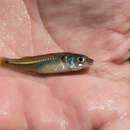en
names in breadcrumbs


Craterocephalus marjoriae és una espècie de peix pertanyent a la família dels aterínids.[4]
És capaç de fresar múltiples vegades entre el setembre i el gener (amb un màxim de l'activitat reproductora a principis de la temporada). Ha estat reproduït en captivitat.[5][8][9]
Menja principalment insectes aquàtics i llurs larves, microcrustacis, algues i ous de peixos.[8]
És un peix d'aigua dolça, bentopelàgic i de clima tropical (24°C-30°C).[5][10]
És un endemisme d'Austràlia.[5][11]
És inofensiu per als humans.[5]
Craterocephalus marjoriae, commonly known as Marjorie's hardyhead or silverstreak hardyhead, is a species of fish in the family Atherinidae that is native to eastern Australia, namely central Queensland to northeastern New South Wales.[1] Here it inhabits clear flowing streams and it is common among the vegetation in their margins. It prefers shallow water over streambeds consisting of sand or gravel. It forms shoals. They spawn on multiple occasions between September and January, although this peaks earlier in the season.[2] They form pairs for spawning, the eggs being deposited on aquatic vegetation to which they adhere. The eggs are large measuring 1.15-1.25 mm in diameter and have adhesive filaments. The eggs hatch after around a week and the larvae measure about 5.7 mm standard length.[3] Their diet consist mostly of aquatic insects and their larvae, small crustaceans, algae and fish eggs.[2] This species was described by Gilbert P. Whitley in 1948 with the type locality given as Eidsvold on the Burnett River in Queensland.[4] Whitley may have named this species in honour of his sister Marjorie Frewer.[5]
Craterocephalus marjoriae, commonly known as Marjorie's hardyhead or silverstreak hardyhead, is a species of fish in the family Atherinidae that is native to eastern Australia, namely central Queensland to northeastern New South Wales. Here it inhabits clear flowing streams and it is common among the vegetation in their margins. It prefers shallow water over streambeds consisting of sand or gravel. It forms shoals. They spawn on multiple occasions between September and January, although this peaks earlier in the season. They form pairs for spawning, the eggs being deposited on aquatic vegetation to which they adhere. The eggs are large measuring 1.15-1.25 mm in diameter and have adhesive filaments. The eggs hatch after around a week and the larvae measure about 5.7 mm standard length. Their diet consist mostly of aquatic insects and their larvae, small crustaceans, algae and fish eggs. This species was described by Gilbert P. Whitley in 1948 with the type locality given as Eidsvold on the Burnett River in Queensland. Whitley may have named this species in honour of his sister Marjorie Frewer.
Craterocephalus marjoriae Craterocephalus generoko animalia da. Arrainen barruko Actinopterygii klasean sailkatzen da, Atherinidae familian.
Craterocephalus marjoriae Craterocephalus generoko animalia da. Arrainen barruko Actinopterygii klasean sailkatzen da, Atherinidae familian.
Craterocephalus marjoriae is een straalvinnige vissensoort uit de familie van de koornaarvissen (Atherinidae).[1] De wetenschappelijke naam van de soort is voor het eerst geldig gepubliceerd in 1948 door Whitley.
Bronnen, noten en/of referenties馬氏硬頭魚,為輻鰭魚綱銀漢魚目銀漢魚科的其中一種,分布於澳洲淡水流域,體長可達8.5公分,為熱帶魚類,棲息在流動快速、砂石底質的溪流,生活習性不明。